|


|
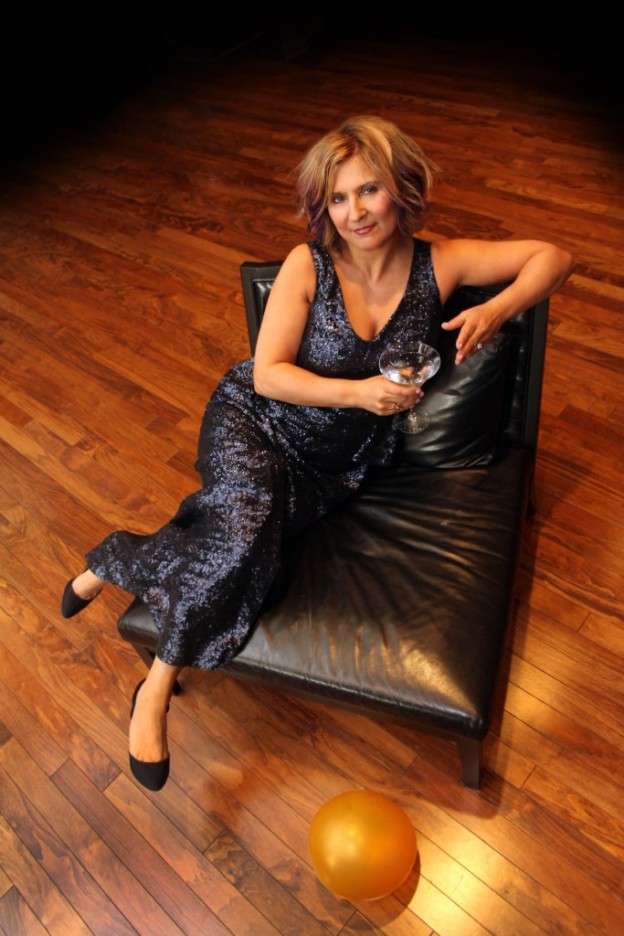
Janis Siegel, a nine-time Grammy winner, seventeen-time Grammy nominee, and founding member of the vocal group The Manhattan Transfer, will perform at Swarthmore College this Sunday, February 11th. In addition to her success with The Manhattan Transfer, she has also led a successful solo career, releasing almost a dozen albums that have garnered consistently high critical and popular praise. While working with The Manhattan Transfer, Siegel established herself as a dynamic songwriter as well as a skilled vocalist. She wrote five charts for the acclaimed Vocalese and seven charts for the Grammy-winning Brasil, as well as the charts for “Why Not?” and “Sassy,” both of which earned the group Grammys. In 1989, after recording and touring with The Manhattan Transfer for more than a decade, she released Short Stories with jazz pianist Fred Hersch, which Jazz Times ranked “among the most graceful, thoroughly heartbreaking efforts of the modern era, thanks to her rich, emotive vocals.” In 1993, she and the other members of The Manhattan Transfer received honorary doctorates from the Berklee School of Music, and in 1999 they were among the first class of inductees into the Vocal Group Hall of Fame. She continues to tour with The Manhattan Transfer, as well as with her own band, and teaches master classes while remaining an active member of the music scene. Her recent projects have spanned several genres, from participating in improvisational vocal performances to curating CDs that feature such vocal legends as Lisa Fisher and Kellylee Evans.
Siegel helped usher in a renaissance of American vocal-based music. Her early work with The Manhattan Transfer came at a time when jazz music was primarily an arena for instrumental musicians. Siegel’s powerful vocals on The Manhattan Transfer’s first records forced people to rethink this assumption, while her solo career cemented her place as both a preternaturally talented vocalist and as a versatile songwriter. Through the years she has influenced not only jazz music, but vocal performance in general. She attributes this partly to one of the unchanging, transcendent characteristics of music: “I think people will always respond to emotion and to great songs sung well,” she says. “And I think the vocalists in particular will always be in demand. There’s nothing that approximates the human voice. In the end, when you come down to it, people want to feel something.”
Don’t miss Janis Siegel this Sunday, February 11th at 7:30pm in Lang Concert Hall. She will perform with pianist John DiMartino, bassist Gerald Veasley, and tenor sax Andrew Neu, who is also Director of the Swarthmore College Jazz Ensemble. The event is free and open to the public. She will also be giving a master class in the Lang Concert Hall at 3:00 pm on the same day, and will be performing with the Swarthmore College Jazz Ensemble in April.
Gabriel Hearn-Desautels ’20
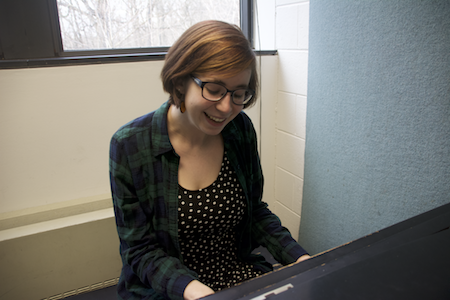
Music major and biology minor Rachel Hottle ’18 considers herself to have taken “a liberal arts approach to music,” exploring many musical skills and concepts instead of sticking to just one. She plays both the flute and piano, and sings in the Swarthmore College Chorus, Garnet Singers, and Grapevine acapella group. She also composes music herself, including a piece based on Emily Dickinson’s poem, “We Grow Accustomed to the Dark,” that was performed in the Swarthmore College Chorus concert last fall.
Hottle has found inspiration in female composers and songwriters. “I was trained in classical flute and piano but most of the composers of classical music tend to be dead white men, which was not the most inspiring thing for me growing up,” she said. “It’s hard to look up to Mozart as a young girl. So I play primarily classical music but I draw my inspiration from Joni Mitchell, Carole King, [etc]. I really look up to female singer-songwriters.”
Her interest in the gender imbalance present in classical music has stayed with her throughout her time at Swarthmore, influencing her senior recital. “My initial idea was, ‘I wanna do a recital that has only music by female composers,’ but I have since discovered that that’s kind of difficult since there aren’t a lot of female composers,” Hottle said. She instead adjusted her plans to feature “mainly non- dead white men” in her recital.
Hottle’s senior recital will be “a little more eclectic than most senior recitals,” according to her, including singing, flute, guitar, duets with friends, and a song from Grapevine. “Playing with other people has been an important way that I’ve connected with people outside of your typical social interactions,” she said. “One of my closest friends who graduated, we would just hang out all the time and sing and play the guitar and just harmonize together.”
She has cultivated this love of group music-making since she was 12, when her church asked her to play piano to fill a gap in their ensemble.
“I think that was pretty central to my musical formation, being forced to do things that were a little bit beyond my ability,” she said. “I had to improvise on the fly and learn how to be really flexible, which I think really helped me in group music-making.”
After leaving the tight-knit Swarthmore community where she participated in so many ensembles, Hottle plans to study music cognition in a graduate program. She will also continue playing music as well as studying it.
“Regardless of what I’m doing, I definitely want to keep playing after I leave Swat and I’m not sure how that works in the real world…are there community groups that you can join? Do you just hang up flyers saying ‘who wants to jam with me?’ I don’t know.”
Bayliss Wagner ’21
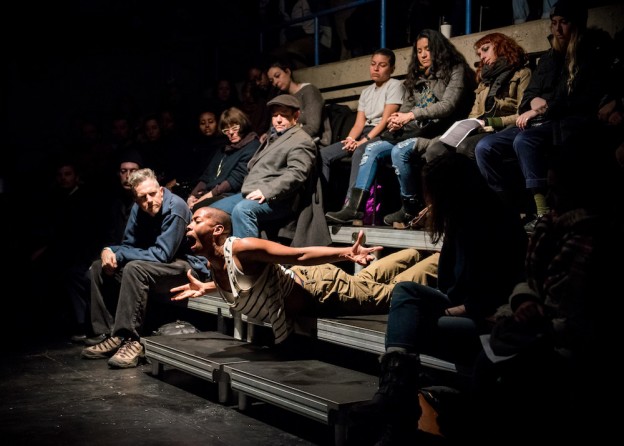
From February 2nd to the 10th, “The Black Magic of Living,” part of the Cooper Series, will take place at Swarthmore College. Artist-scholars Thomas DeFrantz and Ni’Ja Whitson will be in residency giving talks, master classes, and performances in a multi-dimensional meditation on being Black in America. DeFrantz’s and Whitson’s dance performances were inspired by the poetry of Jean Toomer and Marlon Riggs, respectively, two artists who pushed beyond the traditional boundaries of their mediums to tell stories of the origins and lives of African Americans at specific times in history. The resulting performances are complex, layered examinations of some of the biggest questions facing American society today.
Thomas DeFrantz’s work, CANE, explores stories of African-American sharecropping. Inspired by Harlem Renaissance author Jean Toomer’s 1923 text of the same name, CANE uses a digitally-constructed canefield to create a “responsive environment” that the dancers interact with. Toomer’s text was highly experimental for its time, combining poetry, drama, stories, and sketches to tell stories of the origins and experiences of African-Americans in the United States. In the way that Toomer pushed beyond traditional literary boundaries, DeFrantz stretches typical expectations of visual art and, in this case, dance. His use of technology to create the canefield – the piece of the dance that would most immediately place the work in a specific historical context – gives credence to the idea that the present cannot be understood without first understanding the past. DeFrantz and his company will perform CANE on February 2 and 3 at 8:00 PM in LPAC’s Frear Ensemble Theater.
Ni’Ja Whitson’s A Meditation on Tongues is a more physically expansive piece. At one point, both dancers take turns reciting a speech about the inability to “go home” as a black gay man. While one speaks, the other runs around the entire performance space before trading places with the speaker. As they repeat this over and over, their speaking becomes more laborious, symbolizing the physical and emotional strain of alienation. A Meditation on Tongues is a performance art adaptation of Marlon T. Riggs’s film, Tongues Untied. Whitson’s piece explores ideas and questions about loss at the height of the AIDS crisis, while reimagining images of Black and Queer masculinities. Whitson’s work also relies heavily on history to present an altered picture of the present, and will be performed in LPAC’s Frear Ensemble Theater on February 9 and 10 at 8:00 PM.
By framing these questions of identity in different historical contexts, Whitson proves that finding answers is difficult if one simply looks at a single event or time period. History is a living entity, and every event must be considered not only in its present context, but in terms of the ideas, beliefs, and circumstances that led to it over time. Both of these artists have created works that channel this idea toward the concept of being Black in America. Their pieces are visceral and challenging, and ask as many questions as they answer.
The Cooper Series is supported by the William J. Cooper Foundation, which provides a varied program of lectures, performances and exhibitions which enriches the academic work of Swarthmore College. The Foundation was established by William J. Cooper who specified that the income from his gift should be used “in bringing to the college eminent citizens of this and other countries who are leaders in statesmanship, education, the arts, sciences, learned professions and business.” Planning for next season is currently underway.
From February 2nd to the 10th, both artists will be giving talks and master classes in addition to their performances. Information can be found here:https://www.swarthmore.edu/cooper-series/black-magic-living.
Gabriel Hearn-Desautels ’20
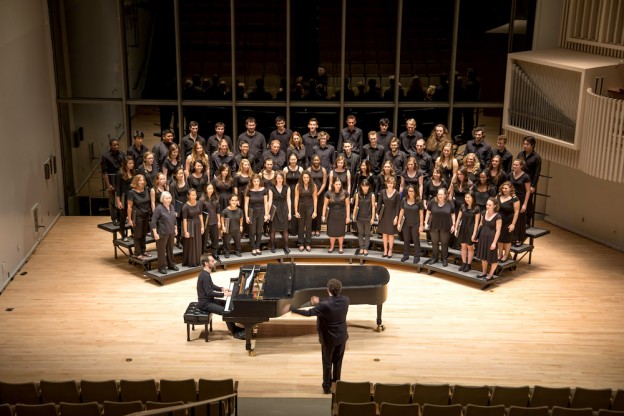
The Swarthmore College Chorus and Garnet Singers concert on Saturday, December 9 at 3:00 PM invites its audience to celebrate not only Bach’s music on the 500th anniversary of the Protestant Reformation, but also the voices and experiences of minority composers. The unexpected repertoire, chosen by director Joseph Gregorio, will feature Bach’s “Magnificat,” performed by the entire Swarthmore College Chorus and Orchestra. The Garnet Singers, a subset of the chorus composed of students at the college, will sing pieces around the theme of light and dark.
Though the Garnet Singers will be performing Bach with a piece called “O Jesu Christ Meins Lebens Licht,” the majority of their pieces come from composers not typically represented in classical choral music, such as women, African-Americans, and people of Native American descent. “I’m very aware that it’s difficult for women and minorities to be represented fairly in the classical concert hall and it’s something I wanted to try and work toward with this programming,” Gregorio said. “I try to pick music from throughout history and from as broad a diversity of composers as makes sense.”
From capturing despair to celebrating hope, these composers each bring their own diverse responses to the Garnet Singer’s theme. One piece not only responds to darkness but attempts to make sense of it through a poem by Emily Dickinson, “We Grow Accustomed to the Dark.” Alto section leader Rachel Hottle ’18 composed the piece this year and will perform as a soloist. Two compositions that evoke a sense of hope are “Sure on this Shining Night” by Samuel Barber and “My Lord, What a Mornin,’” composed by the grandfather of African-American spiritual arrangers, H. T. Burleigh. “The setting is very much at dawn,” Gregorio said of the Burleigh piece. “There’s darkness and there’s the realization of approaching light.”
One of the most unorthodox pieces of the repertoire is the Ute Sundance, a piece sung with vocables instead of lyrics. Ethan Sperry adapted the composition for chorus with the permission of Valerie Naranjo, who based the original composition off of a yearly ritual that her Ute ancestors performed. “The Sundance was historically a very difficult and painful dance ritual,” Gregorio said. “It was thought that through the Sundance, all of the grudges and disappointments and bad feelings of the previous year are cleansed and washed away, so it’s a ritual of purification, really, and the idea that was by the suffering taken on by these dancers, the community was washed clean of all of those bad feelings.”
Reena Esmail, who was a new student at Juilliard when the Twin Towers fell, composed “Ritual” in the wake of the attacks. The “constellation of notes that evoke fear and uncertainty,” as Gregorio notes, express the apprehension that Esmail felt. She based her composition off of a William Stafford poem that she encountered in class the day before 9/11: “As we…began to reel at the overwhelming magnitude and gravity of the situation, there was only one phrase that emerged from the chaos. It was the last line of Stafford’s poem. The darkness around us is deep,” she writes on her blog.
During the second half of the concert, the college chorus and the orchestra will perform “Magnificat,” a liturgical composition based on a Latin biblical hymn. Andrew Kim ’18 will perform as assistant conductor of the piece. In addition, for the first time in many years, professional vocalists will perform with the group, including Swarthmore voice instructors Clara Rottsolk and Nancy Jantsch. This year marks 500 years since Martin Luther posted his 95 theses, initiating the Protestant Reformation. Luther greatly influenced Johann Sebastian Bach, whose musical career is closely associated with the Lutheran reformation. “The music of Johann Sebastian Bach is one of the most beautiful results of the Reformation, so I wanted to pay some sort of homage to that,” Gregorio said. “The spectacle of the chorus singing Bach, whose music is very intricate, very florid, but absolutely glorious in sound—I’d like to think that could lift anyone out of a bad mood.”
The pieces that the chorus will perform at their fall concert will evoke emotions ranging from despair to apprehension to joy. The depth of the repertoire will provide an enriching and awe-inspiring experience for all who attend.
Bayliss Wagner ’21
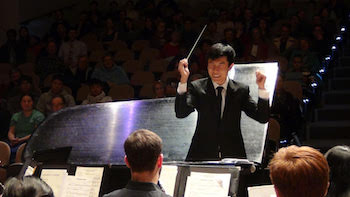
|
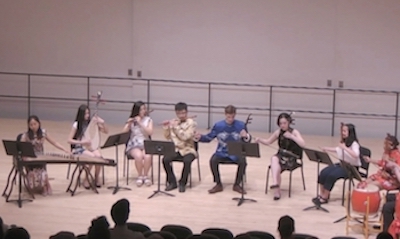
On Sunday, December 10 at 7:30 PM in Lang Concert Hall, the Chinese Music Ensemble will perform its debut concert as an official Swarthmore College ensemble. The group had previously been part of the Fetter Chamber Music program, performing only in the Fetter concerts each semester. Now, the group has sixteen members, with students performing on traditional Chinese instruments including the guzheng (zither), erhu (bowed fiddle), pipa (plucked lute), yangqin (hammered dulcimer), dizi (flute), and percussion.
Directed by Professor Lei Ouyang Bryant and Performance Associate Wang Guowei, the ensemble performs traditional and contemporary music from different regions of China and the Chinese Diaspora. Professor Bryant, who joined the Department of Music and Dance this fall, plays erhu in the ensemble, which she studied along with guzheng in Taiwan, China, and the U.S. Wang, an internationally touring erhu soloist and composer, has directed Chinese ensembles at Wesleyan University, Williams College, NYU, and the Westminster Choir College. He also arranged the versions of the folk songs that the ensemble will be performing in this concert. The program includes Cantonese folk song “Riding in the Countryside,” a medley of three folk songs, Ding Guoshun’s “Spring of Happiness,” Fan Shange and Geshanjida’s “Spring in the Snow-capped Mountains,” Taiwanese folk song “Catching Mud Carp,” Hunan folk song “Chestnut Flower,” and Jian Guangyi and Wang Zhiwei’s “New Song of the Herdsman.” The concert will feature soloists Annie Tingfang Wang, Henry Han ‘20, and Josephine Hung ‘19.
Desta Pulley
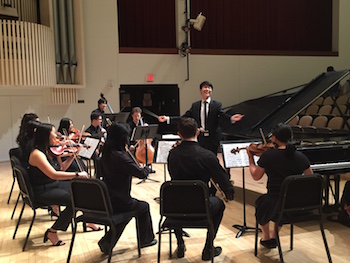
In response to increased student interest in conducting, Professor Andrew Hauze introduced the Lab Orchestra in the fall of 2016 as a way to give those students practice. This spring, they performed at the Pennsylvania Academy of Fine Arts (PAFA) thanks to Concert and Production Manager Jenny Honig’s efforts to find off-campus performance opportunities for the group. This semester, Swarthmore College Lab Orchestra co-conductors Andrew Kim ’18 and Shira Samuels-Shragg ’20 have had the experience of conducting not only the Lab Orchestra, but also the Jasper String Quartet, a Philadelphia-based group of professional musicians.
“Having a lab orchestra like this is very rare for an undergraduate program,” Kim says. “This is usually a model for graduate conducting programs. I don’t know of any other conducting opportunities even at bigger universities that undergrad students can get that parallels this kind of experience… it’s remarkable what we as a small department can do and the development that has happened in the past couple years thanks to Andrew and Jenny.”
According to Shragg, the rehearsals with the Lab Orchestra have allowed her to explore different interpretations of the pieces because she can ask the group to perform the piece in different ways. “You get the score, you go through it, and you try to figure out what everything means and what ideas you want to bring to it,” Shragg says. “The perfect situation is that you have such a strong image and understanding of how you want the piece to sound that you can simultaneously hear the orchestra, what they’re playing, and the idealized version you have in your head, and bring the orchestra to meet your vision for the piece. What’s fun with Lab Orchestra is because…it’s literally like a lab, we get to play around, whereas you could never walk into an L.A. [Philharmonic] rehearsal and say ‘oh, I’d like to try this passage three different ways.’ In this setting you can do that, we have done that.”
Kim says that conducting for professional musicians has facilitated the improvement of both the student conductors and musicians. “There’s more of a direct feedback with musicians have been playing in orchestras for a long time, so they can give pointed tips that work really well both for the players and us too,” he says. “I’ve just found that everything that they say clicks with both the musicians and me a lot.” Though the group gives feedback, Kim is still able to assert his own creative agency in the pieces that he conducts. “In my two semesters of working with them, I’ve found the space that I need to still be that leader,” he says. “Even though they’re much more accomplished musicians than I am, they’re good about still giving me that space and allowing me to do what I need to do.”
According to Shragg, the Jasper String Quartet prepares her for her career path as a conductor. “It’s different, but it’s great practice because anything that we get to conduct in the real world, that’s how it’s going to be,” Shragg says.
This weekend, Shragg and Kim will debut their holiday repertoire—featuring Sir Edward Elgar’s Introduction and Allegro, Covelli’s Christmas Concerto in G minor, Op. 5, No. 8, and “Winter” from Vivaldi’s Four Seasons—at the PAFA rotunda on December 3 at 2:00 P.M. and during the second half of the Fetter Chamber Music Concert on December 2 at 8 P.M. The Jasper String Quartet will be featured in the Elgar pieces as well as performing solos in the Covelli. Kim took the Jasper String Quartet’s suggestion of the Elgar pieces because of the beauty of the music as well as the late Romantic-era style. “I think it’s a challenging piece for our group but they’ve really kind of risen to the challenges of this piece,” Kim says.
Shragg, on the other hand, will conduct the Vivaldi and Corelli pieces. She was inspired to conduct Vivaldi’s “Winter” after hearing it played during her Music Theory class. Hauze suggested the Corelli as her first piece to conduct “because unlike the Elgar, it’s not super dense. It’s still beautiful and there’s a lot to explore there but it’s more manageable,” Shragg says. The Christmas Concerto was composed to follow the story of Jesus’s birth.
The common thread that ties the pieces that both Shragg and Kim have chosen for their fall repertoire is nature. The Elgar piece an English pastoral, the Corelli has a movement called “pastorale,” and the Vivaldi has its own corresponding poem that includes lines like “shivering, frozen mid the frosty snow in biting, stinging winds; running to and fro to stamp one’s icy feet, teeth chattering in the bitter chill.” Both hope that Swarthmore students who attend their performance will be inspired by the wonder of nature, without having to feel the “teeth-chattering,” “stinging” winter weather.
“[The element of nature] is something that’s close to Swarthmore students because we go to school in an arboretum,” Kim said “I hope that at a particularly busy time of the semester it can help people to take a break and even if they’re not outside in cold nature, they can experience nature kind of vicariously in our pieces.”
Bayliss Wagner ’21
This year’s Fall Dance Concert will feature Taiko, modern, tap, and classical ballet, along with a work by Pitch (a dance co.), and pieces by student choreographers Marion Kudla and Sophie Gray-Gaillard. Performances will be held on December 8th at 4:30pm and December 9th at 8pm. Both shows are free and open to the public.
As part of the class on Pointe and Partnering that she teaches, Dance Professor Chandra Moss-Thorne often stages excerpts from classical ballets that require pointe work. Last year, for example, students performed the snow section from The Nutcracker. This year, Professor Moss-Thorne has staged the Jewels Divertissement from Sleeping Beauty, one of the most iconic divertissements in all of classical ballet. With music by Tchaikovsky and choreography by Marius Petipa, considered the most influential ballet choreographer in history, the short piece is a beautiful and efficient display of the most that classical ballet has to offer.
Pitch (a dance co.) will perform their piece, Request. Pitch is a “cross-disciplinary incubator” from the works of the accomplished dancers and choreographers Meredith Webster and Tania Isaac. The company combines modern and balletic techniques with “converging forms and ideas.” Request is a duet that the pair created in response to dance requests submitted to them by outside parties. With music by Arvo Part, the piece “is a collage of short dances that thread together the memory of people, relationships, fears, aspirations and moments in time.”
Marion Kudla ‘19 and Sophie Gray-Gaillard ‘20 will each present contemporary pieces that they have been working on since last spring. Both have trained extensively in classical and contemporary techniques and have been interested in choreography for a long time. Their pieces are part of their work for Dance Lab with Professor Kim Arrow. Kudla’s piece expands upon Thoreau’s idea that “the most alive is the wildest.” Her work, Imprints, “is inspired by places of wilderness, by places that remind us of what it is to be freed.” Gray-Gaillard’s work is a solo that focuses on the fluidity of the body’s movement through space, a style she admires in the work of Alonzo King and the Cambrians, among others. She based a large amount of her work in the convergences of improvisational and choreographed movement.
Each semester, the Dance Concert is a chance for students to share the hard work they have put into each of their classes, and for student choreographers to offer their first exciting takes on various dance forms. The concerts showcase the powerful dynamism of Taiko, the rapidly-evolving techniques of modern dance, and the rhythmic beauty of tap, along with new interpretations of classical and contemporary ballet. Swarthmore’s Dance Program gives voices to many different styles of dance, and the concerts are the realization of those voices.
Gabriel Hearn-Desautels ’20
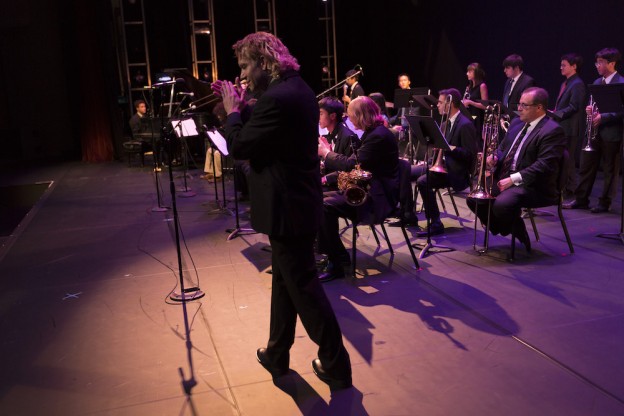
On Sunday, November 19th, the Swarthmore College Jazz Ensemble will perform in Lang Concert Hall. The concert begins at 7:30 and will feature the 21-piece student ensemble. They will perform a cross-section of music from the Great American Songbook, Latin jazz, big band standards and modern rock. Andrew Neu has been the conductor of the ensemble since 2014 and continues the long tradition of big band jazz at Swarthmore.
The program begins with the jazz standard “In a Mellow Tone,” composed by Duke Ellington. This arrangement was written by saxophonist Oliver Nelson and recorded by the Buddy Rich Big Band. It features freshman trumpeter, Owais Noorani-Kamtekar. The appropriately titled “Kids Are Pretty People,” by Thad Jones, was originally composed to be performed in the tiny jazz clubs of New York City. This performance features Sam Gardner on trombone. “What is This Thing Called Love” was composed by Cole Porter and arranged by conductor Andrew Neu. This up-tempo treatment features Vaughn Parts on alto saxophone and Josh Freier on tenor saxophone. Josh is again featured on the jazz ballad “Misty,” a tune made famous by Johnny Mathis. The first half wraps up with a very atypical piece for jazz ensemble. Originally recorded by the rock band Radiohead, “Bodysnatchers” has been adapted for big band by Fred Sturm. It was commissioned by the Lawrence University Jazz Ensemble and features Nathan Anderson on soprano saxophone, Sumi Onoe on piano, and Max Marckel on baritone saxophone.
The second half begins with “Cottontail,” another Duke Ellington piece, this one arranged by Duke himself. Olivia Gubler takes the lead on tenor sax. “Lament” is a haunting ballad composed by trombonist J.J. Johnson, and features Ben Hejna and the entire trombone section. Eric Chen plays a Debussy-inspired solo interlude on piano in the middle of the piece. Continuing with another intimate piece by Thad Jones, “Tip Toe” is based on the chord progression to “I Got Rhythm” in the less standard key of Ab. It features the saxophone section up front and a challenging trombone and bass soli featuring Derek Kinsella on the bass. Audiences will also hear solos from Owais, Josh, and Nathan, this time on alto saxophone.
The finale of the concert is an epic Latin jazz piece by trumpeter Arturo Sandoval called “A Mis Abuelos.” This tribute to his grandparents naturally features the trumpet section, along with Dakota Gibbs on guitar. Seth Stancroft drives it to the end with an open drum solo.
This year, the Department of Music and Dance is very excited to host jazz singer Janis Siegel at Swarthmore. She is a founding member of the musical group Manhattan Transfer and a multiple Grammy-award winner. On February 11, she will lead a workshop and perform a concert with pianist John DiMartino, bassist Gerald Veasley, and Andrew Neu on saxophone. She will join the Swarthmore College Jazz Ensemble for a special concert on April 7. This is a great opportunity to hear a world-renowned musician perform with the talented jazz students of Swarthmore College.